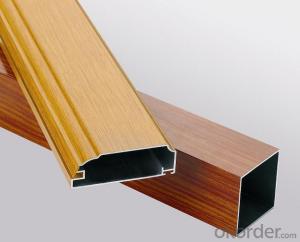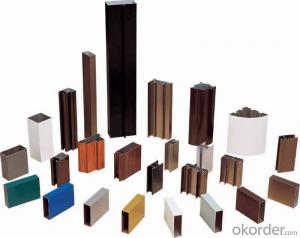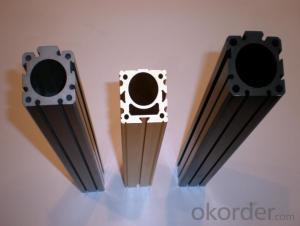best selling colorful anodizing aluminium profiles
- Loading Port:
- China Main Port
- Payment Terms:
- TT OR LC
- Min Order Qty:
- -
- Supply Capability:
- -
OKorder Service Pledge
Quality Product, Order Online Tracking, Timely Delivery
OKorder Financial Service
Credit Rating, Credit Services, Credit Purchasing
You Might Also Like
Aluminium profile
1) Alloy: AA6061, AA6063
2) Temper: T5, T6
3) Series of surface treament:
1. Mill Finished
2. Anodizing: Silver, champagne, light bronze, dark bronze, black, light titanium, dark titanium.
3. Electrophoretic Coating: Silver, champagne, bronze, black, light bronze, dark bronze.
4. Electrostatic Color Powder Coating: Normal color, special color.
5. Fluorocarbon Powder Spraying: Normal color, special color.
6. Wood Grain Coating: Import paper, domestic paper.

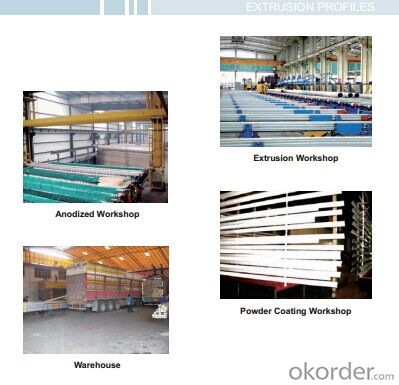
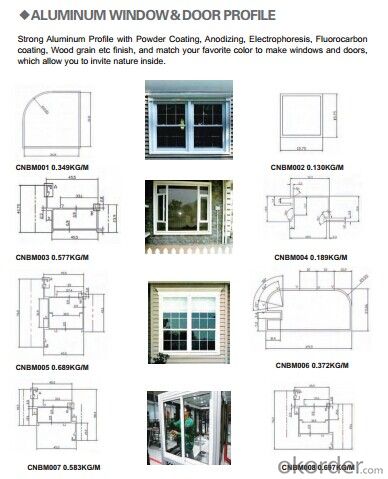
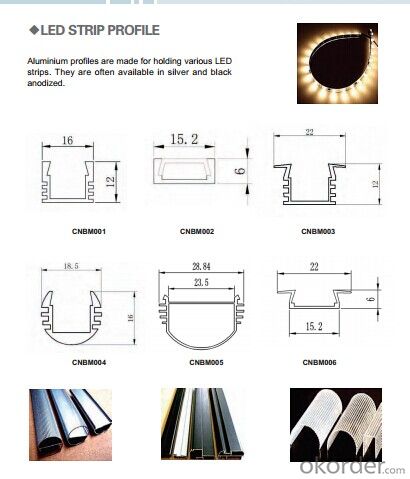

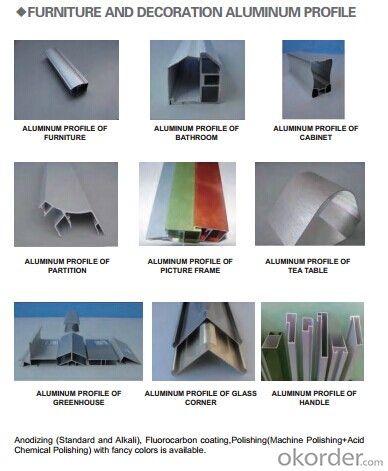
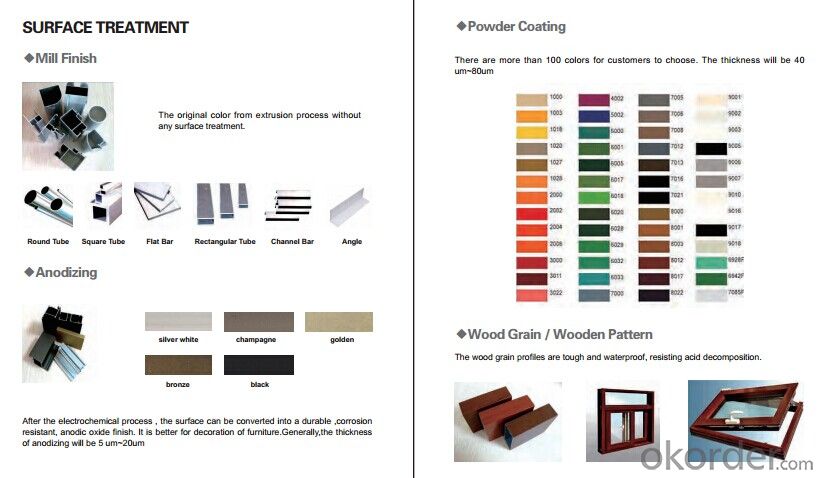
- Q:Are aluminum profiles suitable for use in furniture fittings and accessories?
- Yes, aluminum profiles are suitable for use in furniture fittings and accessories. Aluminum is lightweight, durable, and resistant to corrosion, making it an ideal material for various furniture applications. Additionally, aluminum profiles can be easily fabricated into different shapes and designs, allowing for versatility in furniture design.
- Q:Can aluminum profiles be used in the production of transportation containers?
- Yes, aluminum profiles can be used in the production of transportation containers. Aluminum is a lightweight and durable material that is widely used in various industries, including transportation. It offers several advantages for container production, such as corrosion resistance, high strength-to-weight ratio, and ease of fabrication. Aluminum profiles can be used to construct the framework and walls of transportation containers, providing structural integrity while keeping the overall weight of the container low. Additionally, aluminum profiles can be easily customized and shaped to fit specific container requirements. Overall, the use of aluminum profiles in transportation container production offers numerous benefits and is a popular choice among manufacturers.
- Q:Does aluminum alloy profile conduct electricity?
- Aluminum conducts well, and aluminium alloys must also be electrically conductive. But aluminum alloys contain impurities such as silicon and magnesium
- Q:Can aluminum profiles be an alternative to steel or other materials?
- Many applications can consider aluminum profiles as a viable alternative to steel or other materials. Aluminum profiles possess several advantages over steel, including their lightweight nature, corrosion resistance, and durability. The low weight of aluminum profiles is a key benefit. Aluminum is approximately one-third the weight of steel, making it ideal for weight reduction purposes. Its lightweight property also makes it easier to handle, transport, and install, which ultimately reduces costs and labor requirements. Furthermore, aluminum profiles exhibit excellent corrosion resistance, especially when compared to steel. When exposed to air, aluminum naturally forms a protective oxide layer that prevents further oxidation and corrosion. This makes aluminum profiles suitable for industries such as construction, automotive, aerospace, and marine, where exposure to moisture, saltwater, or harsh weather conditions is common. Another advantage of aluminum profiles is their high strength-to-weight ratio. Aluminum alloys can be engineered to provide exceptional strength while still being lightweight. This makes them an excellent choice for structural applications that require both strength and weight reduction. In addition, aluminum profiles are highly durable and can withstand extreme temperatures. Aluminum has a melting point of 660 degrees Celsius, which is significantly higher than most other non-ferrous metals. This makes it suitable for applications where exposure to high temperatures or thermal stress is expected. Aluminum profiles are also easily fabricated, allowing for complex shapes and designs. They can be extruded, machined, welded, or formed into various configurations to meet specific requirements. This flexibility in manufacturing processes makes aluminum profiles a versatile material choice. However, it is important to note that aluminum profiles may not be suitable for all applications. Steel still offers superior strength and rigidity, making it more appropriate for heavy-duty applications or areas requiring high impact resistance. Additionally, the cost of aluminum profiles can be higher compared to steel, depending on the specific alloy and manufacturing processes involved. In conclusion, aluminum profiles can be considered as a viable alternative to steel or other materials in many applications. Their lightweight nature, corrosion resistance, high strength-to-weight ratio, durability, and ease of fabrication make them an attractive choice for various industries. However, it is crucial to carefully consider the specific requirements of each application before deciding on the most suitable material.
- Q:Changhe brand aluminum can?
- Profile is not bad, but visibility is not too large, the whole is still very good, cost-effective
- Q:How much is aluminum freight per kilometer per ton?
- China Logistics Network: batch transportation more than 30 tons, 40 yuan per ton per ton
- Q:Can aluminum profiles be painted or coated?
- Aluminum profiles possess the ability to undergo painting or coating processes. The versatility of aluminum as a material allows for easy application of paint or coating, thereby enhancing its appearance, providing corrosion resistance, and improving durability. Numerous techniques exist for painting or coating aluminum profiles, such as powder coating, anodizing, and liquid coating. Powder coating stands as a favored option due to its capacity to deliver a lasting and consistent finish, while anodizing forms a protective oxide layer on the aluminum's surface. Conversely, liquid coating offers a broad spectrum of colors and finishes. In summary, painting or coating represents an effective and practical choice for individuals seeking to alter color, enhance aesthetics, or safeguard aluminum profiles.
- Q:What are the different surface polishing options for aluminum profiles?
- Aluminum profiles offer various surface polishing options, each with its own shine and finish levels. These methods include mechanical polishing, chemical polishing, electrolytic polishing, and anodizing. Mechanical polishing involves using abrasives and polishing compounds to physically eliminate surface imperfections and achieve a smooth, reflective finish. This can be done manually or with automated machines. While it provides a high shine, it requires careful attention to detail and multiple steps. Chemical polishing, on the other hand, employs chemical solutions to dissolve a thin layer of aluminum, resulting in a smoother surface. It is often used for large-scale production due to its quick and uniform application, but it may not offer the same level of shine as mechanical polishing. Electrolytic polishing utilizes an electric current to eliminate surface imperfections and create a polished finish. By using the aluminum profile as an anode and a conductive material as the cathode, electrolytic polishing produces a mirror-like finish with excellent precision and uniformity. Although not a polishing method itself, anodizing is a commonly used surface treatment for aluminum profiles. It involves creating a protective oxide layer on the metal's surface through an electrochemical process. Anodizing enhances the appearance of profiles by providing a smooth, colored, or clear finish, while also improving their durability and resistance to corrosion. The choice of surface polishing option depends on factors such as the desired shine level, the complexity of the profile's design, and the intended application. It is essential to consider cost, time, and quality requirements when selecting the most suitable option, as each method has its advantages and limitations.
- Q:Are aluminum profiles suitable for roofing systems?
- Yes, aluminum profiles are suitable for roofing systems. They are lightweight, durable, and have excellent corrosion resistance, making them ideal for withstanding harsh weather conditions. Additionally, aluminum profiles provide versatility in design and can be easily fabricated to meet specific roofing requirements.
- Q:Are there any specific requirements for transporting and storing aluminum profiles?
- Yes, there are specific requirements for transporting and storing aluminum profiles. When it comes to transporting aluminum profiles, it is important to ensure that they are adequately protected to avoid any damage during transit. This can be done by using appropriate packaging materials such as foam or cardboard to provide cushioning and prevent any scratches or dents. Additionally, the profiles should be securely fastened or strapped in place to prevent movement or shifting during transportation. In terms of storage, it is crucial to store aluminum profiles in a dry and well-ventilated area to prevent any moisture accumulation, which can lead to corrosion. They should be kept away from direct sunlight and extreme temperatures, as excessive heat can cause distortion or warping of the profiles. Furthermore, it is recommended to store the profiles in a horizontal position to prevent any bending or sagging. If vertical storage is necessary, proper support should be provided to ensure that the profiles remain straight and undamaged. Overall, following these requirements for transporting and storing aluminum profiles will help maintain their integrity and ensure their quality upon arrival or when retrieved for use.
1. Manufacturer Overview |
|
|---|---|
| Location | |
| Year Established | |
| Annual Output Value | |
| Main Markets | |
| Company Certifications | |
2. Manufacturer Certificates |
|
|---|---|
| a) Certification Name | |
| Range | |
| Reference | |
| Validity Period | |
3. Manufacturer Capability |
|
|---|---|
| a)Trade Capacity | |
| Nearest Port | |
| Export Percentage | |
| No.of Employees in Trade Department | |
| Language Spoken: | |
| b)Factory Information | |
| Factory Size: | |
| No. of Production Lines | |
| Contract Manufacturing | |
| Product Price Range | |
Send your message to us
best selling colorful anodizing aluminium profiles
- Loading Port:
- China Main Port
- Payment Terms:
- TT OR LC
- Min Order Qty:
- -
- Supply Capability:
- -
OKorder Service Pledge
Quality Product, Order Online Tracking, Timely Delivery
OKorder Financial Service
Credit Rating, Credit Services, Credit Purchasing
Similar products
New products
Hot products
Related keywords
